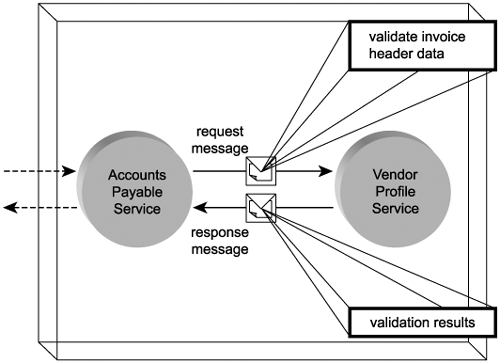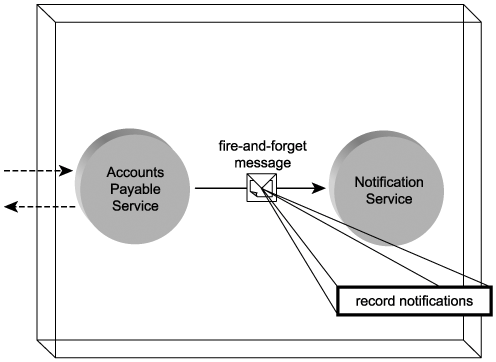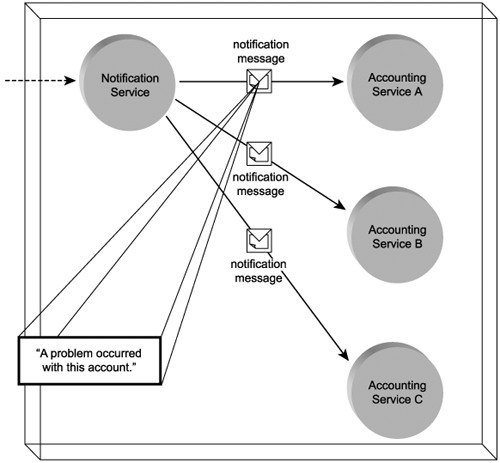Message exchange patterns
Every task automated by a Web service can differ in both the nature of the application logic being executed and the role played by the service in the overall execution of the business task. Regardless of how complex a task is, almost all require the transmission of multiple messages. The challenge lies in coordinating these messages in a particular sequence so that the individual actions performed by the message are executed properly and in alignment with the overall business task (Figure 6.2).
Figure 6.2. Not all message exchanges require both requests and responses.

Message exchange patterns (MEPs) represent a set of templates that provide a group of already mapped out sequences for the exchange of messages. The most common example is a request and response pattern. Here the MEP states that upon successful delivery of a message from one service to another, the receiving service responds with a message back to the initial requestor.
Many MEPs have been developed, each addressing a common message exchange requirement. It is useful to have a basic understanding of some of the more important MEPs, as you will no doubt be finding yourself applying MEPs to specific communication requirements when designing service-oriented solutions.
6.1.1. Primitive MEPs
Before the arrival of contemporary SOA, messaging frameworks were already well used by various messaging-oriented middleware products. As a result, a common set of primitive MEPs has been in existence for some time.
Request-response
This is the most popular MEP in use among distributed application environments and the one pattern that defines synchronous communication (although this pattern also can be applied asynchronously).
The request-response MEP (Figure 6.3) establishes a simple exchange in which a message is first transmitted from a source (service requestor) to a destination (service provider). Upon receiving the message, the destination (service provider) then responds with a message back to the source (service requestor).
Figure 6.3. The request-response MEP.
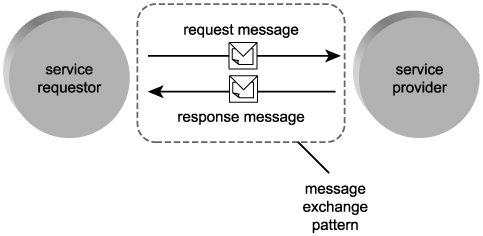
Note that within this MEP, services typically require a means of associating the response message with the corresponding request message. This can be achieved through correlation, a concept explained in Chapter 7.
Fire-and-forget
This simple asynchronous pattern is based on the unidirectional transmission of messages from a source to one or more destinations (Figure 6.5).
Figure 6.5. The fire-and-forget MEP.
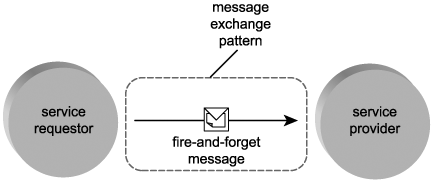
A number of variations of the fire-and-forget MEP exist, including:
- The single-destination pattern, where a source sends a message to one destination only.
- The multi-cast pattern, where a source sends messages to a predefined set of destinations.
- The broadcast pattern, which is similar to the multi-cast pattern, except that the message is sent out to a broader range of recipient destinations.
The fundamental characteristic of the fire-and-forget pattern is that a response to a transmitted message is not expected.
Complex MEPs
Even though a message exchange pattern can facilitate the execution of a simple task, it is really more of a building block intended for composition into larger patterns. Primitive MEPs can be assembled in various configurations to create different types of messaging models, sometimes called complex MEPs.
A classic example is the publish-and-subscribe model. Although we explain publish-and-subscribe approaches in more detail in Chapter 7, let's briefly discuss it here as an example of a complex MEP.
The publish-and-subscribe pattern introduces new roles for the services involved with the message exchange. They now become publishers and subscribers, and each may be involved in the transmission and receipt of messages. This asynchronous MEP accommodates a requirement for a publisher to make its messages available to a number of subscribers interested in receiving them.
The steps involved are generally similar to the following:
|
Step 1. |
The subscriber sends a message to notify the publisher that it wants to receive messages on a particular topic. |
|
Step 2. |
Upon the availability of the requested information, the publisher broadcasts messages on the particular topic to all of that topic's subscribers. |
This pattern is a great example of how to aggregate primitive MEPs, as shown in Figure 6.7 and explained here:
- Step 1 in the publish-and-subscribe MEP could be implemented by a request-response MEP, where the subscriber's request message, indicating that it wants to subscribe to a topic, is responded to by a message from the publisher, confirming that the subscription succeeded or failed.
- Step 2 then could be supported by one of the fire-and-forget patterns, allowing the publisher to broadcast a series of unidirectional messages to subscribers.
Figure 6.7. The publish-and-subscribe messaging model is a composite of two primitive MEPs.
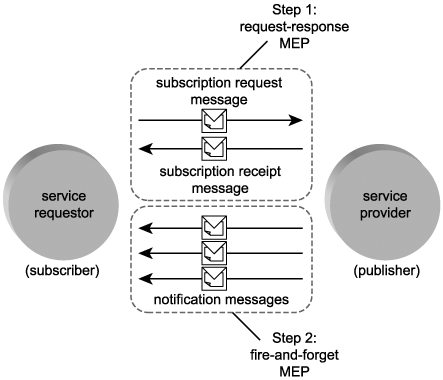
WS-* specifications that incorporate this messaging model include:
- WS-BaseNotification
- WS-BrokeredNotification
- WS-Topics
- WS-Eventing
Concepts relating to these specifications are discussed in the next chapter as part of the Notification and eventing section.
6.1.2. MEPs and SOAP
On its own, the SOAP standard provides a messaging framework designed to support single-direction message transfer. The extensible nature of SOAP allows countless messaging characteristics and behaviors (MEP-related and otherwise) to be implemented via SOAP header blocks. The SOAP language also provides an optional parameter that can be set to identify the MEP associated with a message. (Note that SOAP MEPs also take SOAP message compliance into account.)
6.1.3. MEPs and WSDL
Operations defined within service descriptions are comprised, in part, of message definitions. The exchange of these messages constitutes the execution of a task represented by an operation. MEPs play a larger role in WSDL service descriptions as they can coordinate the input and output messages associated with an operation. The association of MEPs to WSDL operations thereby embeds expected conversational behavior into the interface definition.
WSDL operations support different configurations of incoming, outgoing, and fault messages. These configurations are equivalent to message exchange patterns, but within the WSDL specification, they often are referred to simply as patterns. It is important to note that WSDL definitions do not restrict an interface to these patterns; they are considered minimal conversational characteristics that can be extended.
Release 1.1 of the WSDL specification provides support for four message exchange patterns that roughly correspond to the MEPs we described in the previous section. These patterns are applied to service operations from the perspective of a service provider or endpoint. In WSDL 1.1 terms, they are represented as follows:
- Request-response operation Upon receiving a message, the service must respond with a standard message or a fault message.
- Solicit-response operation Upon submitting a message to a service requestor, the service expects a standard response message or a fault message.
- One-way operation The service expects a single message and is not obligated to respond.
- Notification operation The service sends a message and expects no response.
Of these four patterns (also illustrated in Figure 6.9), only the request-response operation and one-way operation MEPs are recommended by the WS-I Basic Profile.
Figure 6.9. The four basic patterns supported by WSDL 1.1.
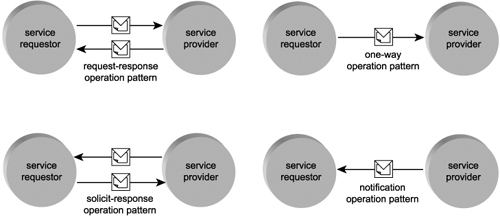
Not only does WSDL support most traditional MEPs, recent revisions of the specification have extended this support to include additional variations. Specifically, release 2.0 of the WSDL specification extends MEP support to eight patterns (and also changes the terminology) as follows.
- The in-out pattern, comparable to the request-response MEP (and equivalent to the WSDL 1.1 request-response operation).
- The out-in pattern, which is the reverse of the previous patternwhere the service provider initiates the exchange by transmitting the request. (Equivalent to the WSDL 1.1 solicit-response operation.)
- The in-only pattern, which essentially supports the standard fire-and-forget MEP. (Equivalent to the WSDL 1.1 one-way operation.)
- The out-only pattern, which is the reverse of the in-only pattern. It is used primarily in support of event notification. (Equivalent to the WSDL 1.1 notification operation.)
- The robust in-only pattern, a variation of the in-only pattern that provides the option of launching a fault response message as a result of a transmission or processing error.
- The robust out-only pattern, which, like the out-only pattern, has an outbound message initiating the transmission. The difference here is that a fault message can be issued in response to the receipt of this message.
- The in-optional-out pattern, which is similar to the in-out patternwith one exception. This variation introduces a rule stating that the delivery of a response message is optional and should therefore not be expected by the service requestor that originated the communication. This pattern also supports the generation of a fault message.
- The out-optional-in pattern is the reverse of the in-optional-out pattern, where the incoming message is optional. Fault message generation is again supported.
Until version 2.0 of WSDL becomes commonplace, these new patterns will be of limited importance to SOA. Still, it is useful to know in what direction this core standard is heading.
Note
Version 2.0 of the WSDL specification was originally labeled 1.2. However, the working group responsible for the new specification decided that the revised feature set constituted a full new version number. Therefore, 1.2 was changed to 2.0. However, you still may find references to version 1.2 in some places. WSDL 2.0 is not yet widely used, and details regarding this version of the specification are provided here as they demonstrate the broadening applicability of MEPs.
6.1.4. MEPs and SOA
MEPs are highly generic and abstract in nature. Individually, they simply relate to an interaction between two services. Their relevance to SOA is equal to their relevance to the abstract Web services framework. They are therefore a fundamental and essential part of any Web services-based environment, including SOA.
|
SUMMARY OF KEY POINTS |
|---|
|
Introduction
- Why this book is important
- Objectives of this book
- Who this book is for
- What this book does not cover
- How this book is organized
- Additional information
Case Studies
- Case Studies
- How case studies are used
- Case #1 background: RailCo Ltd.
- Case #2 background: Transit Line Systems Inc.
Part I: SOA and Web Services Fundamentals
Introducing SOA
- Introducing SOA
- Fundamental SOA
- Common characteristics of contemporary SOA
- Common misperceptions about SOA
- Common tangible benefits of SOA
- Common pitfalls of adopting SOA
The Evolution of SOA
- The Evolution of SOA
- An SOA timeline (from XML to Web services to SOA)
- The continuing evolution of SOA (standards organizations and contributing vendors)
- The roots of SOA (comparing SOA to past architectures)
Web Services and Primitive SOA
- Web Services and Primitive SOA
- The Web services framework
- Services (as Web services)
- Service descriptions (with WSDL)
- Messaging (with SOAP)
Part II: SOA and WS-* Extensions
Web Services and Contemporary SOA (Part I: Activity Management and Composition)
- Web Services and Contemporary SOA (Part I: Activity Management and Composition)
- Message exchange patterns
- Service activity
- Coordination
- Atomic transactions
- Business activities
- Orchestration
- Choreography
Web Services and Contemporary SOA (Part II: Advanced Messaging, Metadata, and Security)
- Web Services and Contemporary SOA (Part II: Advanced Messaging, Metadata, and Security)
- Addressing
- Reliable messaging
- Correlation
- Policies
- Metadata exchange
- Security
- Notification and eventing
Part III: SOA and Service-Orientation
Principles of Service-Orientation
- Principles of Service-Orientation
- Service-orientation and the enterprise
- Anatomy of a service-oriented architecture
- Common principles of service-orientation
- How service-orientation principles inter-relate
- Service-orientation and object-orientation (Part II)
- Native Web service support for service-orientation principles
Service Layers
- Service Layers
- Service-orientation and contemporary SOA
- Service layer abstraction
- Application service layer
- Business service layer
- Orchestration service layer
- Agnostic services
- Service layer configuration scenarios
Part IV: Building SOA (Planning and Analysis)
SOA Delivery Strategies
- SOA Delivery Strategies
- SOA delivery lifecycle phases
- The top-down strategy
- The bottom-up strategy
- The agile strategy
Service-Oriented Analysis (Part I: Introduction)
- Service-Oriented Analysis (Part I: Introduction)
- Service-oriented architecture vs. Service-oriented environment
- Introduction to service-oriented analysis
- Benefits of a business-centric SOA
- Deriving business services
Service-Oriented Analysis (Part II: Service Modeling)
- Service-Oriented Analysis (Part II: Service Modeling)
- Service modeling (a step-by-step process)
- Service modeling guidelines
- Classifying service model logic
- Contrasting service modeling approaches (an example)
Part V: Building SOA (Technology and Design)
Service-Oriented Design (Part I: Introduction)
- Service-Oriented Design (Part I: Introduction)
- Introduction to service-oriented design
- WSDL-related XML Schema language basics
- WSDL language basics
- SOAP language basics
- Service interface design tools
Service-Oriented Design (Part II: SOA Composition Guidelines)
- Service-Oriented Design (Part II: SOA Composition Guidelines)
- Steps to composing SOA
- Considerations for choosing service layers
- Considerations for positioning core SOA standards
- Considerations for choosing SOA extensions
Service-Oriented Design (Part III: Service Design)
- Service-Oriented Design (Part III: Service Design)
- Service design overview
- Entity-centric business service design (a step-by-step process)
- Application service design (a step-by-step process)
- Task-centric business service design (a step-by-step process)
- Service design guidelines
Service-Oriented Design (Part IV: Business Process Design)
- Service-Oriented Design (Part IV: Business Process Design)
- WS-BPEL language basics
- WS-Coordination overview
- Service-oriented business process design (a step-by-step process)
Fundamental WS-* Extensions
- Fundamental WS-* Extensions
- You mustUnderstand this
- WS-Addressing language basics
- WS-ReliableMessaging language basics
- WS-Policy language basics
- WS-MetadataExchange language basics
- WS-Security language basics
SOA Platforms
Appendix A. Case Studies: Conclusion
EAN: 2147483647
Pages: 150
